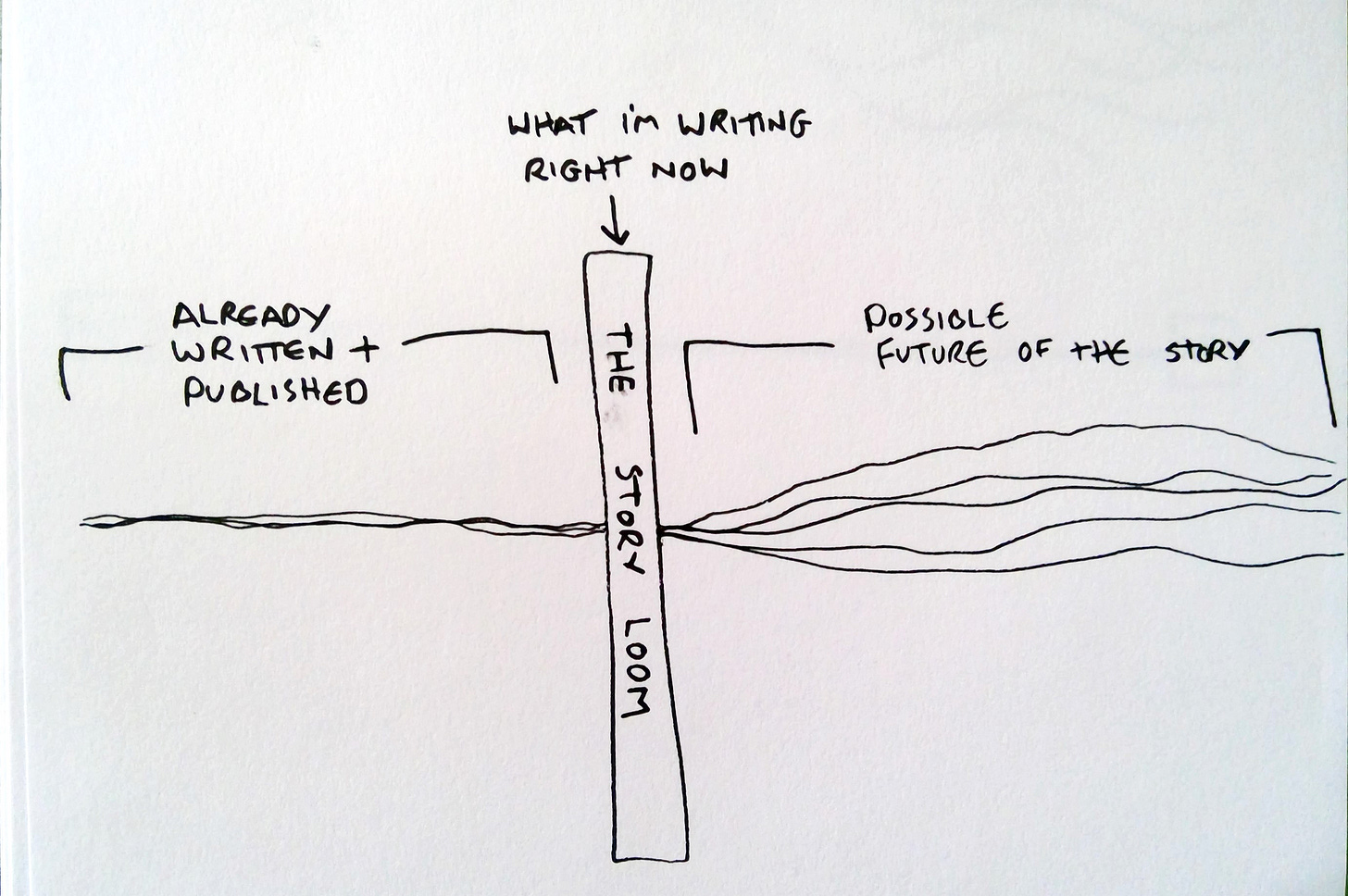I stumbled upon an interesting discussion over on Notes, started by
, about the nature of planning. James muses on how an outline can often be wonderfully succinct and impactful due to its reduced nature:The act of translating a strong outline into a successful finished piece is a weird mix of arcane magic and practical technique.
followed up with this:Which obviously got my attention because I have a +1 in my narcissist attribute (and tend to roll with advantage). I wrote about using themes back in December 2021, which is evidently a stupidly long time ago. Here’s that original post:
Use themes like a compass
We’re nearly at the end of 2021. Another deeply odd year, to put it mildly. If 2020 was a year on pause, 2021 has been a year of janky buffering, playing a few seconds before getting stuck again on the loading wheel of doom. I hope everyone reading this is getting whatever support they need to keep on going through these strange times.
What that post really lacked, I think, were some sketchy illustrations. This morning, after reading the thread from James and Sara over on Notes, I got to thinking in a bit more detail about how I like to plan.
The infinite storyverse
When an idea for a brand new project arrives, it tends to have a specific ‘what if?’ core, but is otherwise very fuzzy. It hasn’t been planned or written or thought about yet, so that initial concept can be a starting point for a million other ideas, all spiralling off into endless potential pages of text.
A bit like this:
It’s an incredibly exciting moment in the creation of your story because anything is possible. Not only are there infinite possibilities, you also haven’t yet had to decide upon any of them or commit to the page. That means you haven’t made any bad decisions yet! It’s an innocent time.
Not very practical, though. A full-on ‘pantser’ might just go with it from here, starting on the left and finding their way along the storyverse strands. If that’s you and it works for you then brilliant. It must be a thrilling way to write, and I’m slightly jealous. Every writing session would be a moment of pure discovery.
For me, I need some clarity, not least because I write and publish in serial form as I go. I don’t have the luxury of viewing the completed manuscript and editing it prior to publication.
Bringing order to chaos
Back when I was a teenager, and into my 20s, I was a major planner. I’d plot everything out to ridiculous detail, create story ‘bibles’, define characters, draw maps - a vast amount of prep work, although curiously I rarely ever finished an actual manuscript. 🤔
Basically, I was aiming to turn that branching storyverse into this:
I wanted to collapse of all of those quantum possibilities into a single sacred storyline (to borrow a term from Loki). The plot was everything! If the plot wasn’t perfect, everything else would fall apart, because plot = story.
That’s what I thought back then, and that focus on plot above all else derailed my writing for actual decades.
Again, if being super precise with your plotting works for you, then brilliant. None of this is about telling you how you ‘should’ write. Do whatever works. Everyone does it differently.
For me, nailing the plot down so precisely before I’d even started writing caused numerous problems:
It made the writing process boring. I knew what was coming, and there was no sense of discovery for me. Consequently, it probably would have felt the same for readers.
There was no room in The Plan for new ideas, and I’ve since come to realise that most of my really good ideas come during the writing process, not before.
I would convolute character motivations in order to adhere to the pre-ordained plot. In that sense, the plot was less of a guide and more of a prison. Shackled to my own story.
When I started writing serial fiction in 2015, I simultaneously started experimenting with a different way of planning my books. It wasn’t really a deliberate thing, more a necessity of the way I was releasing weekly chapters. I needed to know what was coming down the pipe, so that I could layer in foreshadowing, character development and so on rather than it just feeling like I was making it up each week.
I also didn’t want to be too precise, though, for all the reasons outlined above.
Introducing the Story Loom
Where I ended up was with a layered method. I’d have a firm idea of what was happening in the upcoming half dozen chapters. The following ten-or-so I’d have a decent notion of what would happen, but it wasn’t quite as focused. Get further from my current writing position and the planning would become ever-looser.
In other words, if you’ll excuse the grandiose metaphor, I had started using a story loom.
You know, a loom. Admittedly I don’t know much about how they work, but I do know that they take lots of disparate strands and pull them together into a more coherent whole.
Like this:

Bear with. This’ll make sense in a moment.
Remember the chaotic storyverse graphic up the top? The story loom is a way of bringing that under control. Check this out:
On the left we have the story already told and committed to the page. In my case, those chapters have been published and gone out on the newsletter.
On the right there’s all the strands of the storyverse, still loose and able to be re-weaved.
In the middle is the loom, which is where I’m currently at with the writing. As strands start to be pulled together ahead of the loom, they come into clearer focus. The far distance is still flexible, but becomes less so the closer I get to writing those chapters.
Story milestones
There’s an additional detail, which is the application of key story milestones. I use these to ensure that my stories have clear purpose and direction. Even if the route from A to B goes in unexpected directions, I’ll still arrive at B eventually.
This is useful for anyone writing and publishing a serial chapter-by-chapter. A story milestone can be anything: a character decision, or a specific plot point or twist, or the resolution of a key theme. They are anchors in the story’s future.
It looks a bit like this:
Note the little squares, and how the possible story strands all converge on them. Because I know about upcoming milestones, even if they are six months or further away from where I’m writing, I can layer in some foreshadowing and clues, which makes for a more satisfying reading experience.
I can still explore and alter the in-between moments, but it ensures that I’m not just making it up as I go - which can be a frequent frustration for readers with serials, and is seen especially on television. That creeping sense that Lost, Battlestar Galactica, Game of Thrones and countless others are fumbling about in the dark and that you’re possibly wasting your time by watching them on the assumption that they’re headed somewhere interesting.
Milestones are not invulnerable. They can be broken, but that can only happen for a very good reason. To re-thread and completely diverge away from a milestone in favour of a newer one requires the emergence of a really damned good idea.
How do you plan?
So that’s me. How about you? Do you make it up as you go, plan precisely, or land somewhere in the middle like I do?
A big factor is how you publish, of course. If you write entire manuscripts before publishing or seeking publication, that has very different requirements to publishing as you go.
Another consideration is your writing style. I write in a linear fashion, starting at the beginning and writing through to the end of the story. That’s a very useful way to do it for the creation of a weekly serial. If your technique requires you to hop in and out of different parts of a manuscript, piecing it together over time like a puzzle, then a lot of what I’ve outlined here probably won’t be all that useful.
As always, there’s no right or wrong way to go. The only important thing is to write. Everything else is negotiable.
Thanks for reading. And thanks to James and Sara for the thought prompt this morning over breakfast.
Over in Inktober land, I’ve been struggling to keep up with the daily delivery but have been thoroughly enjoying it nonetheless. Here are the latest attempts:



To wrap up, here’s a couple of ebook giveaways that you can use to stock up your shelves:
See you on Friday for more Triverse.










Very cool concept. I like it. Your visual sketches were perfect to illustrate the ideas 👌
I'm all over the place, but mostly a pantster (though I'll be honest, I had to google what that was) -- for some things I've written over the last half year, I've just had to watch and see where it was going. Thrilling, yes; disorganised, yes 😆
The loom is good though. I think that's probably a bit more where I'm at. Things solidify, but there's many a possible path ahead. The only issue is, for me that forward thread is mostly invisible. I just have to feel it out and feed it in.
I love outlining, but it is positively useless to me. My poor brain numbly but thoroughly believes I've already written the book once I know what it's about. So I use the kind of half-outline bullet point one. And I have to do the Dickens-by-way-of-Hama thing of not knowing more than 1 or 2 pages ahead.